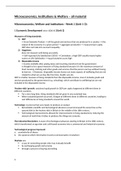College aantekeningen
College aantekeningen en literatuur Microeconomics, Institutions And Welfare (ECB1MI) ECONOMY P, ISBN: 9780198810247
- Instelling
- Universiteit Utrecht (UU)
- Boek
- The Economy
In dit document staat de benodigde stof voor het vak Microeconomics, Institutions and Welfare. Het document omvat de hoorcolleges en de benodigde literatuur.
[Meer zien]




